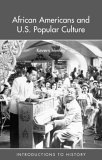
Kevern Verney: African Americans and US Popular Culture 2003, Routledge (130 pages).
Starting off with the degrading representation of blacks in Minstrel Shows at the end of the 19th century, Kevern Verney gives insight to the different roles African Americans have played in music, movies, literature (covered less thoroughly) and sports, and their simultaneous fight for Civil Rights and fair representation and participation in popular culture. Biases and prejudices were used to prevent African Americans from participating in US society as a whole, but these measures were eventually broken down, albeit not without struggles. From the minstrels through The Harlem Renaissance. From radio to TV, and acknowledging music as African Americans' largest contribution to US popular culture. Major figures in the book are Jack Johnson, Paul Robeson, Sidney Portier, Malcom X and Martin Luther King Jr., plus an array of musicians from Bert Williams through Miles Davis to Public Enemy. They all represent important aspects and eras of the African American history. Verney has a background as a lecturer in American History at college level, and his vast knowledge is apparent throughout the book. His writing is smooth while at the same time presenting the topic with the seriousness it deserves.
One of the recurring themes in the book is minstrelsy. Verney starts his story with minstrel shows and tells about the degrading representation of African Americans in them, initially played by white actors in burnt-cork make-up. At the same time they sang songs inspired by African American tradition. Blacks were eventually allowed to play in minstrels, but even they had to wear burnt-cork make-up to ensure caricature was maintained. Verney argues that the minstrel representation has permeated much of African American history in US popular culture even after the shows themselves stopped running. One example he uses is Louis Armstrong and how he at several times while playing opened his eyes wide and rolled them around, a well known minstrel trick to show the contrast between the white of the eyes and the darker skin. The argument is that for a long time such tricks were used to cater to the white audience's prejudices.
I do however have one bone to pick with Verney. While I agree with the fact that biases and prejudices have prevented African American fair participation in US popular culture, I do not think Verney pays enough tribute to how African Americans used their own cultural expressions to comment on their situation even before the Civil Rights movement. Before the advent of minstrelsy, black slaves had work hollers and spirituals that cleverly used metaphors and imagery that would later on be used by both blues and folk artists. Although Verney covers topics such as be bop, 1960's jazz and 1970's funk, he does not, to my opinion, acknowledge that in be bop's case it was a conscious attempt by black jazz musicians to break free from standards set by white swing orchestra-leaders in the early 1940's. The changes in structure and tempo were used both as signs of aggression and as a move from dance music to listening music, that is from "entertainment" to "art". The smaller combos made this sort of playing easier, but it also put the players at center stage, as opposed to the (white) orchestra leaders. Verney gives better attention to the links between the Civil Rights movement and jazz and soul in the sixties and seventies, but even this could have been elaborated a bit more.
Over all, though, I think Kevern Verney has presented a very good history of African Americans in popular culture, even if the shortage of pages may have prevented him from a more in-depth analysis of major developments.
No comments:
Post a Comment